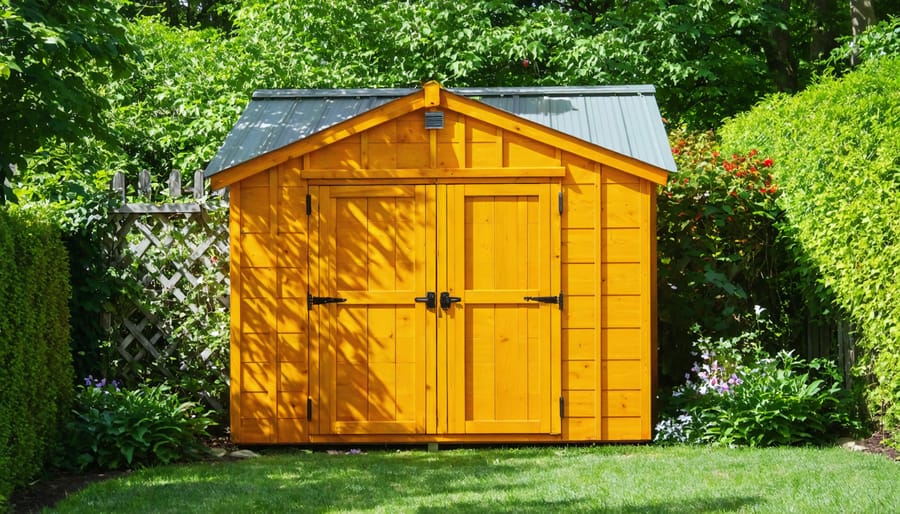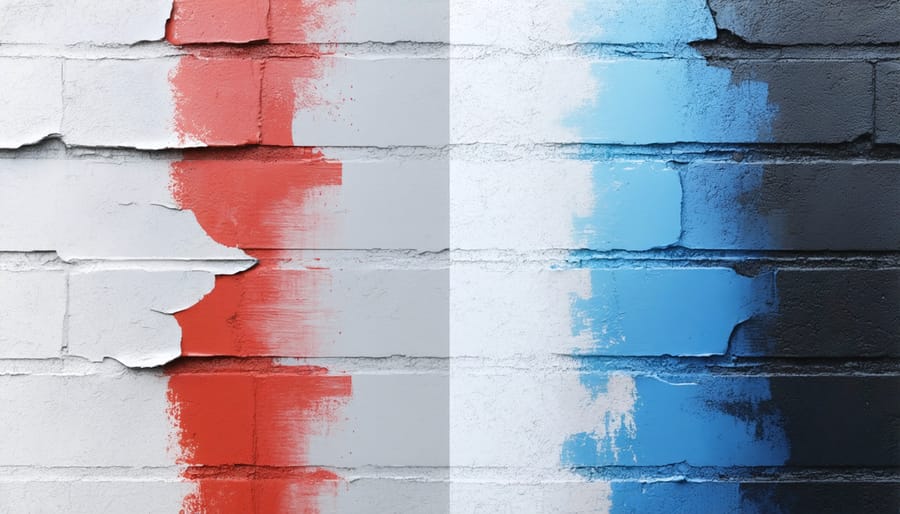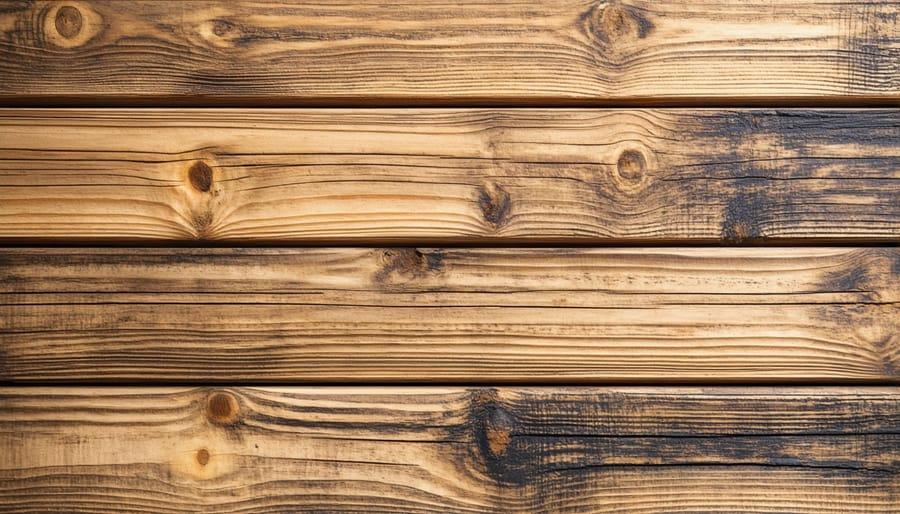Your Wood Shed’s Perfect Paint: Maximum Protection with Minimum Hassle

Protect your wooden shed with premium exterior paint designed specifically for outdoor structures and harsh weather conditions. Latex-based and oil-based paints both offer distinct advantages, with latex providing excellent UV resistance and breathability, while oil-based options deliver superior water protection and durability. Choose moisture-resistant primers and paints rated for exterior wood to prevent rot, mildew, and structural damage that can compromise your shed’s longevity.
Leading options include Sherwin-Williams SuperPaint Exterior, Benjamin Moore Aura Exterior, and BEHR Premium Plus Ultra Exterior – all formulated with advanced technologies to combat moisture penetration while maintaining color vibrancy for years. Consider local climate conditions when selecting your paint: hot, sunny regions benefit from light-reflecting colors with high UV protection, while rainy areas require exceptional waterproofing capabilities.
When properly prepared and painted, your wooden shed can withstand decades of weather exposure while maintaining its appearance. The right paint not only protects your investment but also enhances your property’s visual appeal, making paint selection a crucial decision for long-term shed maintenance.
What Makes the Best Wood Shed Paint?
Weather Resistance Features
When it comes to protecting your shed from the elements, weather resistance features in your paint choice are absolutely crucial. The best paints for wood sheds include specialized UV inhibitors that prevent sun damage and fading, helping your shed maintain its color and structural integrity for years to come. Look for paints that specifically mention UV protection on their labels.
Waterproofing your wood shed starts with choosing a paint that creates a robust moisture barrier. Quality exterior paints contain advanced water-resistant polymers that prevent rain and snow from seeping into the wood, which helps prevent rot, mold, and warping.
Temperature tolerance is another vital feature to consider. The best shed paints can withstand extreme temperature fluctuations without cracking or peeling. Look for products that mention “all-weather protection” or “extreme weather resistance” on their labels. These paints typically maintain their protective properties in temperatures ranging from below freezing to intense summer heat.
For maximum protection, choose paints that offer all three features: UV protection, moisture resistance, and temperature tolerance. This combination will provide the most comprehensive shield against weather-related damage.
Paint Types and Their Benefits
When it comes to protecting your wood shed, you have three main paint types to choose from, each offering unique benefits. Latex paint is a popular choice for its easy application, quick drying time, and excellent UV resistance. It’s also environmentally friendly and easy to clean up with water. The flexibility of latex paint helps it resist cracking and peeling, making it ideal for areas with varying weather conditions.
Oil-based paints provide superior penetration into the wood and create a harder, more durable finish. They’re particularly effective at sealing the wood against moisture and tend to last longer than latex options. While they take longer to dry and require mineral spirits for cleanup, many homeowners prefer them for their exceptional durability and rich finish.
Hybrid paints combine the best of both worlds, offering the durability of oil-based paints with the easy cleanup of latex. These modern formulations provide excellent coverage, strong adhesion, and enhanced weather resistance. Though typically more expensive, hybrids are becoming increasingly popular for their long-lasting protection and user-friendly application process.

Top Paint Recommendations for Wood Sheds
Best Overall Exterior Paint
After extensive testing and real-world applications, Sherwin-Williams SuperDeck Exterior Oil-Based Solid Color Stain stands out as the best overall paint for wood sheds. This premium product offers exceptional protection against harsh weather conditions while maintaining its color and finish for years.
What makes this paint particularly impressive is its unique oil-based formula that penetrates deeply into wood fibers, creating a robust protective barrier against moisture, UV rays, and temperature fluctuations. The solid color stain provides excellent coverage while allowing the wood’s natural texture to show through, giving your shed a professional, attractive appearance.
One gallon typically covers 250-350 square feet, making it cost-effective for most standard-sized sheds. The paint applies smoothly with either a brush or roller and typically requires just two coats for optimal protection. It dries to the touch in about 4 hours, with full cure time of 24-48 hours depending on weather conditions.
Homeowners particularly appreciate this paint’s resistance to cracking, peeling, and fading – common issues with lesser quality products. The mildew-resistant coating also helps keep your shed looking clean and fresh throughout the seasons. While it’s slightly pricier than some alternatives, its durability and long-lasting protection make it a smart investment that can extend your shed’s lifespan significantly.
For best results, always prep your shed’s surface properly and apply during dry weather when temperatures are between 50-90°F.
Best Budget-Friendly Option
When it comes to protecting your wood shed without breaking the bank, Kilz Exterior Latex Paint stands out as an excellent budget-friendly choice. This water-based paint delivers impressive performance at roughly half the price of premium brands, making it a smart investment for cost-conscious homeowners.
What makes Kilz particularly appealing is its built-in primer properties, eliminating the need for a separate primer coat in most cases. This two-in-one feature not only saves money but also reduces your overall project time. The paint provides good coverage, typically requiring just two coats for complete protection, and offers reliable weather resistance that can last 3-5 years with proper maintenance.
Another wallet-friendly option worth considering is Rust-Oleum’s Exterior Paint and Primer. While slightly pricier than Kilz, it still falls comfortably in the budget category and offers enhanced durability. Its mildew-resistant finish helps protect your shed from moisture damage, a crucial feature for outdoor structures.
To maximize your paint’s longevity while keeping costs down, consider these tips:
– Apply during optimal weather conditions (50-85°F, low humidity)
– Clean and sand the surface thoroughly before painting
– Use quality brushes or rollers (which can be cleaned and reused)
– Store leftover paint properly for touch-ups
– Perform annual maintenance checks to address any issues early
Remember, choosing a budget-friendly paint doesn’t mean compromising on quality – it’s about finding the right balance between cost and performance for your specific needs.
Premium Choice for Harsh Climates
When facing extreme weather conditions, investing in premium paint solutions can significantly extend your wood shed’s lifespan. Benjamin Moore’s Aura Exterior Paint stands out as a top performer, offering exceptional durability against harsh UV rays, heavy rainfall, and temperature fluctuations. Its innovative Color Lock Technology ensures the color stays vibrant for years, even in direct sunlight.
For coastal areas where salt spray and high humidity are concerns, Sherwin-Williams Duration Exterior Acrylic Coating provides superior moisture resistance and anti-mildew properties. Its self-priming formula creates a thick, protective barrier that stands up to salt air and prevents wood rot.
PPG Timeless Exterior Paint and Primer delivers outstanding results in areas with extreme temperature variations. Its specialized formula maintains flexibility during freeze-thaw cycles, preventing cracking and peeling. The paint’s ceramic technology creates a shield-like finish that repels water while allowing the wood to breathe.
While these premium options come with a higher price tag, ranging from $50 to $75 per gallon, their enhanced durability and reduced maintenance requirements make them cost-effective long-term investments. One gallon typically covers 350-400 square feet with two coats, and these paints often last 8-10 years before requiring a refresh, compared to 4-5 years for standard exterior paints.
Preparation and Application Tips

Surface Preparation Steps
Proper surface preparation is crucial for achieving a long-lasting paint finish on your wood shed. Start by thoroughly cleaning the surface with a mixture of warm water and mild detergent, removing all dirt, debris, and mildew. Use a pressure washer on a low setting or a scrub brush for stubborn areas, but be careful not to damage the wood.
After cleaning, let the surface dry completely for at least 24 hours. While monitoring your shed’s condition, look for any loose or peeling paint, which should be scraped away using a paint scraper or wire brush. Sand down rough spots and edges with medium-grit sandpaper, followed by fine-grit for a smooth finish.
Pay special attention to any damaged areas. Fill holes, cracks, or splits with exterior wood filler and allow it to dry according to the manufacturer’s instructions. Sand the filled areas until they’re flush with the surrounding surface.
Before painting, wipe down the entire surface with a tack cloth to remove sanding dust. For bare wood or areas where you’ve removed old paint, apply a quality exterior wood primer. This crucial step ensures better paint adhesion and provides an additional moisture barrier. Let the primer dry completely before applying your chosen paint.
Remember to protect surrounding areas by laying down drop cloths and using painter’s tape where needed. Choose a day with moderate temperatures and low humidity for optimal results.
Application Techniques
Proper application is key to achieving a long-lasting finish on your wood shed. Start by thoroughly cleaning the surface with a pressure washer or stiff brush to remove dirt, debris, and loose paint. Allow the wood to dry completely before proceeding.
Choose a day with moderate temperature (between 50-85°F) and low humidity for painting. Avoid painting in direct sunlight or when rain is forecasted within 24 hours. Begin by applying a quality primer, working in manageable sections and following the wood grain. Let the primer dry according to the manufacturer’s instructions.
When applying the paint, use long, smooth strokes with a high-quality brush or roller. Start from the top of the shed and work your way down to prevent drips from marring finished areas. Apply thin, even coats rather than one thick layer, which can lead to bubbling and peeling.
Common mistakes to avoid include:
– Skipping proper surface preparation
– Painting over wet or damp wood
– Using the wrong type of brush or roller
– Applying paint too thickly
– Not allowing adequate drying time between coats
For best results, apply at least two coats of paint, allowing each to dry completely. Pay special attention to corners, edges, and any exposed end grain, as these areas are most vulnerable to moisture damage. Consider adding a third coat to these high-wear areas for extra protection.

Maintenance and Touch-up Guidelines
Regular maintenance is crucial for preserving your shed’s paint job and extending its lifespan. Following these essential shed maintenance tips will help keep your shed looking fresh and protected for years to come.
Inspect your shed’s paint condition every three months, paying special attention to areas prone to wear and tear. Look for signs of peeling, bubbling, or cracking paint, particularly around doors, windows, and corners. Address any issues promptly to prevent moisture damage to the underlying wood.
Keep a small amount of your original paint for touch-ups, properly sealed and stored in a cool, dry place. Before applying touch-up paint, clean the affected area thoroughly with mild soap and water, allow it to dry completely, and lightly sand if necessary. Apply paint in thin, even coats, feathering the edges to blend with the existing finish.
Following proper seasonal care for your shed includes regular cleaning to prevent dirt and debris buildup. Use a soft brush or cloth to dust off surfaces, and gently wash the exterior with a garden hose when needed. Avoid using pressure washers, as they can damage the paint and force water into unwanted areas.
To maintain the paint’s protective qualities, trim back any nearby vegetation that could scratch or damage the surface. Keep gutters clean and functioning to prevent water from running down the sides of your shed. During winter months, remove snow buildup around the base to prevent moisture damage.
If you notice significant wear or fading, plan to repaint your shed every 5-7 years, depending on climate conditions and exposure to elements. This proactive approach will maintain both the appearance and structural integrity of your wood shed.
Choosing the right paint for your wood shed is a crucial decision that impacts both its longevity and appearance. Throughout this guide, we’ve explored various options that can help protect your investment while maintaining its aesthetic appeal. Oil-based exterior paints remain a top choice for their durability and moisture resistance, while latex paints offer excellent color retention and easier cleanup.
Remember that proper preparation is just as important as paint selection. Always clean and sand your shed’s surface, repair any damage, and apply a quality primer before painting. This attention to detail will ensure better paint adhesion and longer-lasting results.
For most wood sheds, we recommend using a premium exterior paint with high-quality acrylic or oil-based formulation. These paints typically offer the best balance of protection, durability, and ease of application. If your shed receives heavy sun exposure, opt for paint with UV inhibitors to prevent fading and wood damage.
Don’t forget about regular maintenance – inspect your shed annually for paint wear and address any issues promptly. A well-maintained paint job can easily last 5-7 years, protecting your shed from moisture, sun damage, and pest infiltration.
By following these guidelines and choosing quality materials, you’ll create a protective barrier that not only preserves your shed but also enhances your property’s overall appearance. Remember, investing in premium paint and proper application techniques now will save you time and money in the long run.

